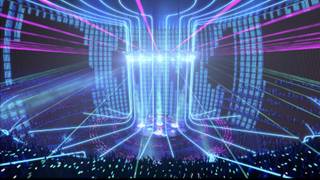The MSG Sphere Las Vegas will be unlike any other Las Vegas arena experience, officials promise.
Madison Square Garden Co. and Las Vegas Sands Corp. on Friday showed off some of the expected features for the 18,500-seat arena planned for behind the Venetian and Palazzo. The immersive environment inside the 360-foot-tall by 500-foot-wide facility will incorporate all five senses.
For instance, state-of-the-art beamforming sound technology will allow audience members to experience dedicated audio, similar to wearing headphones but without the headset. The facility will mainly host concerts, awards shows and other entertainment events.
“Instead of coming out as an ever-expanding wave, it comes out just as it sounds, in a beam,” said Jim Dolan, Madison Square Garden chief executive officer. “There are … thousands and thousands of beams that come out and reach the audience. If you’re sitting in the sphere and we have a comet come fly over you, you’ll hear it coming first, and it goes louder as it reaches its apex over you, then it diminishes and disappears off to the other side.”
The sphere is a giant LED screen — inside and out.
The venue’s exterior is a 580,000-square-foot spherical shape that is wrapped in an open-air trellis structure that includes 190,000 linear feet of LED lighting that is fully programmable to create a digital showcase for brands, artists, events and partners.
The interior features what Madison Square Garden claims to be the largest and highest resolution LED screen in the world. The 170,000-square-foot display will wrap around the interior of the bowl, giving the audience a spectacular view no matter where seated.
Related news
Touch will also be incorporated in the arena with an infrasound haptic flooring system, which utilizes technology to convey bass through the floor for guests to “feel” the experience.
“When you’re riding a Harley, you’ll feel the pistons pumping,” Dolan said. “When lightning strikes, you’ll feel that, too.”
Dolan said most arenas have about 1 megabit of connectivity dedicated for every 5,000 guests. The Sphere will have 20 megabit dedicated for each seat in the arena.
“What will we use it for?” Dolan questioned. “You may have heard of this new technology called AR (augmented reality) or mixed reality … It’s not ready for primetime yet, but when it is, it's going to need a lot of connectivity and your place in Vegas is going to be where they do it first.”
Construction will begin in the summer; the project will be complete by late 2020. It will include a 1,100-foot-long pedestrian bridge connecting the Venetian and Palazzo to the Sphere.
Officials have not released the cost of the project, which is expected to provide 3,500 local construction jobs during the building phase and 4,400 jobs annually once the arena is open, according to a study from Hobbs Ong & Associates. The study said the annual economic benefit from the arena will be around $730 million for venue operation and visitation tied to the facility.
Projections call for $48 million in annual tax revenue, with $7.2 million pegged for the Clark County School District.

